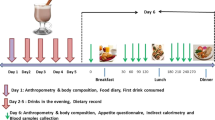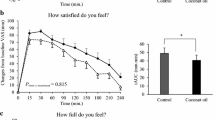Abstract
Purpose
In Caucasian women, research has shown that energy balance and taste preference change throughout the menstrual cycle. However, the contributory role of the menstrual cycle to obesity and insulin resistance among Asian women remains unclear. We investigate the impact of the menstrual cycle on energy balance and taste preference in Singaporean Chinese females.
Methods
Thirty-one healthy young Chinese female subjects with regular menstrual cycles were recruited. Anthropometrics, body composition, energy intake, resting metabolic rate, premenstrual syndrome (PMS) severity and taste preference to sucrose were assessed during three phases (menses, follicular and luteal), over one (N = 18) to two (N = 13) menstrual cycles.
Results
For all subjects (N = 31), we found significant reductions in energy, fat intake (p < 0.05) and taste preference for sucrose (p < 0.05) in the luteal phase compared to early follicular phase as far as Cycle 1 is concerned. No significant differences were observed for carbohydrate and protein intake as well as PMS score. In those evaluated for two full cycles (N = 13), we found that taste preference for sucrose and PMS score were significantly higher in the menstrual phase in Cycle 2 (p < 0.05). No significant differences were observed in energy and macronutrient intake throughout Cycle 2. RMR was similar across the three phases. However, non-significant cyclic variations were noted within and between the cycles.
Conclusion
Cyclic variations in energy intake and expenditure contributed by sensory and behavioural changes occur during the menstrual cycle. Whether this contributes to cyclic weight gain is speculative and remains to be proven. Further research in non-Caucasians spanning more than one menstrual cycle is needed to establish the impact of the menstrual cycle on taste preference and energy balance.


Similar content being viewed by others
References
Low S, Chin MC, Deurenberg-Yap M (2009) Review on epidemic of obesity. Ann Acad Med Singap 38:57–59
WHO (2013) Obesity: Situation and trends. Global Health Observatory (GHO) World Health Organization
Blond E, Maitrepierre C, Normand S, Sothier M, Roth H et al (2011) A new indirect calorimeter is accurate and reliable for measuring basal energy expenditure, thermic effect of food and substrate oxidation in obese and healthy subjects. e-SPEN Eur J Clin Nutr Metab 6:e7–e15
Davidsen L, Vistisen B, Astrup A (2007) Impact of the menstrual cycle on determinants of energy balance: a putative role in weight loss attempts. Int J Obes 31:1777–1785
Buffenstein R, Poppitt SD, McDevitt RM, Prentice AM (1995) Food intake and the menstrual cycle: a retrospective analysis, with implications for appetite research. Phys Behav 58:1067–1077
Dye L, Blundell JE (1997) Menstrual cycle and appetite control: implications for weight regulation. Hum Reprod 12:1142–1151
Dalvit SP (1981) The effect of the menstrual cycle on patterns of food intake. Am J Clin Nutr 34:1811–1815
Johnson WG, Corrigan SA, Lemmon CR, Bergeron KB, Crusco AH (1994) Energy regulation over the menstrual cycle. Physiol Behav 56:523–527
McNeil J, Doucet E (2012) Possible factors for altered energy balance across the menstrual cycle: a closer look at the severity of PMS, reward driven behaviors and leptin variations. Eur J Obstet Gynecol Reprod Biol 163:5–10
Asarian L, Geary N (2013) Sex differences in the physiology of eating. Am J Physiol 305:R1215–R1267
Frank TC, Kim GL, Krzemien A, Van Vugt DA (2010) Effect of menstrual cycle phase on corticolimbic brain activation by visual food cues. Brain Res 1363:81–92
Hamada Y, Shinohara Y, Yano M, Yamamoto M, Yoshio M et al (2013) Effect of the menstrual cycle on serum diamine oxidase levels in healthy women. Clin Biochem 46:99–102
Lohman TG, Roche AF, Martorell R (eds) (1988) Anthropometric standardization reference manual. Human kinetics books, Champaign
Fields DA, Goran MI, McCrory MA (2002) Body-composition assessment via air-displacement plethysmography in adults and children: a review. Am J Clin Nutr 75:453–467
Du Bois D, Du Bois EF (1989) A formula to estimate the approximate surface area if height and weight be known. 1916. Nutrition 5:303–311
Weir JB (1949) New methods for calculating metabolic rate with special reference to protein metabolism. J Physiol 109:1–9
Than TT, Delay ER, Maier ME (1994) Sucrose threshold variation during the menstrual cycle. Physiol Behav 56:237–239
Steiner M, Macdougall M, Brown E (2003) The premenstrual symptoms screening tool (PSST) for clinicians. Arch Womens Ment Health 6:203–209
Bisdee JT, James WP, Shaw MA (1989) Changes in energy expenditure during the menstrual cycle. Br J Nutr 61:187–199
Snell AM, Ford F, Rowntree LG (1920) Studies in basal metabolism. J Am Med Assoc 75:515–523
Solomon SJ, Kurzer MS, Calloway DH (1982) Menstrual cycle and metabolic rate in women. Am J Clin Nutr 36:611–616
Curtis V, Henry CJK, Birch E, Ghusain-Choueiri A (1996) Intraindividual variation in the basal metabolic rate of women: effect of the menstrual cycle. Am J Hum Biol 8:631–639
Howe JC, Rumpler WV, Seale JL (1993) Energy expenditure by indirect calorimetry in premenopausal women: variation within one menstrual cycle. J Nutr Biochem 4:268–273
Piers LS, Diggavi SN, Rijskamp J, van Raaij JM, Shetty PS et al (1995) Resting metabolic rate and thermic effect of a meal in the follicular and luteal phases of the menstrual cycle in well-nourished Indian women. Am J Clin Nutr 61:296–302
Hitchcock FA, Wardwell FR (1929) Cyclic variations in the basal metabolic rate of women. J Nutr 2:203–215
Tai MM, Castillo TP, Pi-Sunyer FX (1997) Thermic effect of food during each phase of the menstrual cycle. Am J Clin Nutr 66:1110–1115
Lissner L, Stevens J, Levitsky DA, Rasmussen KM, Strupp BJ (1988) Variation in energy intake during the menstrual cycle: implications for food-intake research. Am J Clin Nutr 48:956–962
Tarasuk V, Beaton GH (1991) Menstrual-cycle patterns in energy and macronutrient intake. Am J Clin Nutr 53:442–447
Lyons PM, Truswell AS, Mira M, Vizzard J, Abraham SF (1989) Reduction of food intake in the ovulatory phase of the menstrual cycle. Am J Clin Nutr 49:1164–1168
Gong EJ, Garrel D, Calloway DH (1989) Menstrual cycle and voluntary food intake. Am J Clin Nutr 49:252–258
Barr SI, Janelle KC, Prior JC (1995) Energy intakes are higher during the luteal phase of ovulatory menstrual cycles. Am J Clin Nutr 61:39–43
Li ET, Tsang LB, Lui SS (1999) Menstrual cycle and voluntary food intake in young Chinese women. Appetite 33:109–118
Chung SC, Bond EF, Jarrett ME (2010) Food intake changes across the menstrual cycle in Taiwanese women. Biol Res Nurs 12:37–46
Johnson MH (2012) Essential reproduction. Wiley, New York
Cheikh Ismail LI, Al-Hourani H, Lightowler HJ, Aldhaheri AS, Henry CJ (2009) Energy and nutrient intakes during different phases of the menstrual cycle in females in the United Arab Emirates. Ann Nutr Metab 54:124–128
Hardie L, Trayhurn P, Abramovich D, Fowler P (1997) Circulating leptin in women: a longitudinal study in the menstrual cycle and during pregnancy. Clin Endocrinol 47:101–106
Teirmaa T, Luukkaa V, Rouru J, Koulu M, Huupponen R (1998) Correlation between circulating leptin and luteinizing hormone during the menstrual cycle in normal-weight women. Eur J Endocrinol 139:190–194
Frye CA, Crystal S, Ward KD, Kanarek RB (1994) Menstrual cycle and dietary restraint influence taste preferences in young women. Physiol Behav 55:561–567
Wright P, Crow RA (1973) Menstrual cycle: effect on sweetness preferences in women. Horm Behav 4:387–391
Pliner P, Fleming AS (1983) Food intake, body weight, and sweetness preferences over the menstrual cycle in humans. Physiol Behav 30:663–666
Einollahi N, Dashti N, Nabatchian F (2010) Serum leptin concentrations during the menstrual cycle in Iranian healthy women. Acta Med Iran 48:300–303
Quinton ND, Laird SM, Okon MA, Li TC, Smith RF et al (1999) Serum leptin levels during the menstrual cycle of healthy fertile women. Br J Biomed Sci 56:16–19
Shafi R, Afzal MN (2009) Leptin levels during follicular and luteal phases of menstrual cycle. RMJ 34:180–182
Karhunen LJ, Lappalainen RI, Haffner SM, Valve RH, Tuorila H et al (1998) Serum leptin, food intake and preferences for sugar and fat in obese women. Int J Obes Relat Metab Disord 22:819–821
Karlsson AC, Lindroos AK, Lissner L, Torgerson JS, Carlsson B et al (2002) Evidence for gender-specific associations between leptin and olfaction. J Gend Specif Med 5:25–32
Wang M, Seippel L, Purdy RH, Backstrom T (1996) Relationship between symptom severity and steroid variation in women with premenstrual syndrome: study on serum pregnenolone, pregnenolone sulfate, 5 alpha-pregnane-3,20-dione and 3 alpha-hydroxy-5 alpha-pregnan-20-one. J Clin Endocrinol Metab 81:1076–1082
Cross GB, Marley J, Miles H, Willson K (2001) Changes in nutrient intake during the menstrual cycle of overweight women with premenstrual syndrome. Br J Nutr 85:475–482
Trout KK, Basel-Brown L, Rickels MR, Schutta MH, Petrova M, Freeman EW, Tkacs NC, Teff KL (2008) Insulin sensitivity, food intake, and cravings with premenstrual syndrome: a pilot study. J Womens Health (Larchmt) 17:657–665
Sayegh R, Schiff I, Wurtman J, Spiers P, McDermott J et al (1995) The effect of a carbohydrate-rich beverage on mood, appetite, and cognitive function in women with premenstrual syndrome. Obstet Gynecol 86:520–528
Yen JY, Chang SJ, Ko CH, Yen CF, Chen CS et al (2010) The high-sweet-fat food craving among women with premenstrual dysphoric disorder: emotional response, implicit attitude and rewards sensitivity. Psychoneuroendocrinology 35:1203–1212
Livingstone MBE, Black AE (2003) Markers of the validity of reported energy intake. J Nutr 133:895S–920S
Acknowledgments
This study was supported by the Singapore Institute for Clinical Sciences (SICS). It was designed, executed and reported solely by the authors without any external influence. Its content are solely the responsibility of the authors and do not necessarily represent the official views of SICS. The authors have conflicts of interest to declare.
Author information
Authors and Affiliations
Corresponding author
Rights and permissions
About this article
Cite this article
Elliott, S.A., Ng, J., Leow, M.KS. et al. The influence of the menstrual cycle on energy balance and taste preference in Asian Chinese women. Eur J Nutr 54, 1323–1332 (2015). https://doi.org/10.1007/s00394-014-0812-y
Received:
Accepted:
Published:
Issue Date:
DOI: https://doi.org/10.1007/s00394-014-0812-y




